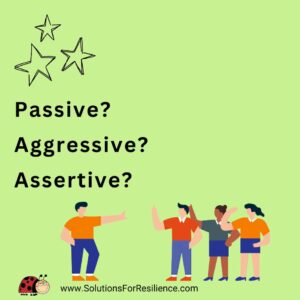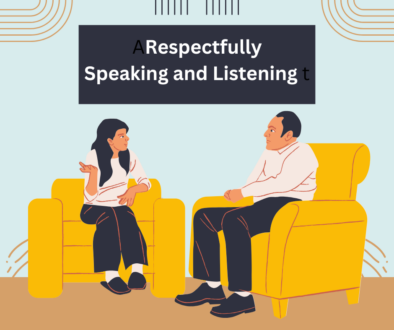Assertiveness Training: How to Improve Your Communication
 Assertiveness Training
Assertiveness Training
The history of assertiveness training began in South Africa with the psychiatrist, Joseph Wolpe. He decided that many of his clients would experience healing if only they communicated with assertiveness. He said, “You cannot be assertive and feel anxious at the same time.”
Then in the 1970s, during the feminist movement, assertiveness techniques, books and workshops appeared, all to support women in speaking for equal rights. In the 1990s I facilitated assertiveness skills for women supported by social assistance. Then came an assertiveness training lull.
Assertiveness and The Nervous System
There is renewed interest in human rights and being more assertive. I hear, “It’s time to be heard.” However, because of research and advancements in psychology and mental health we have more understanding and patience with what used to be labeled aggressive and passive. We now see these communicating patterns more from a nervous system perspective. Please keep that in mind as you read on. Avoid judging yourself or others during moments of emotional flooding or triggering.
At the same time, taking an assertive stance seldom fails. Some people are stuck in a passive or an aggressive position. Years ago, psychologist supervisor, Joan Trimble, told me,
If you want to be stuck, you can find lots of reasons to stay there.
Fortunately, I chose to become assertive and so can you.
One: Assess Your Assertiveness Skills
Here you can score yourself on your frequency of acting passive, aggressive, and assertive. Score your assertive skills from 0 (never do) to 5 (always do):
Part One
1) Say No to unwanted requests
2) Say Yes to exciting opportunities
3) Start conversations
4) Join in conversations
5) Terminate conversations
6) Ask for help
7) Cope with criticism
8) Share feelings, thoughts, and wants
9) State your wants and desires
10) Stay firm with your rights
11) Express your personal opinions
12) Receive compliments, encouragement, and acknowledgement
13) Use boundary statements, sometimes with a clear consequence
Total: _____ A low score may indicate significant passive behavior.
Part Two
1) Listen to seek to understand others
2) Ask questions to understand others
3) Accept No from others
4) Avoid criticizing but offer feedback
5) Acknowledge others’ wants and desires
6) Acknowledge others’ feelings, thoughts, and wants
7) Honor others’ rights
8) Make appropriate apologies
9) Acknowledge others’ personal opinions
10) Give compliments, encouragement, and acknowledgement
11) Use “I” statements
12) Seldom give excuses for own behavior
Total: _____ A low score may indicate significant aggressive behavior.
Part Three
1) Accurately define problem ownership
2) Negotiate no-lose solutions
3) Be aware for both yourself and others body language, facial expressions, and voice volume, tone and, inflection.
5) Express ideas concisely
6) Keep explanations to minimum
Total: _____ A low score indicates you could increase your assertiveness.
Two: Identify Passive, Aggressive, and Assertive Tendencies
Indicators of Passive Tendencies
Gives up relationship with self
BELIEFS
I have no rights
You have all the rights
I am not ok, and you are ok.
BEHAVIOR
Tends to:
- not express wants, thoughts or feelings or expresses them apologetically
- Martyr
- submit to wishes of others
- defer to others
INTENTION
To please and get approval
To be liked at all cost
EMOTIONAL STATE
Low self-esteem
Feels helpless, anxious, used, hopeless, frustrated, judged or resentful, and disconnected
GOALS
To avoid conflict at all cost
To receive love, approval and connection
HOW OTHERS FEEL
Frustrated, angry, pity, guilty or resentful, and disconnected
RESULT
Avoids confrontations, being blamed, risk of disapproval, or being seen as wrong, and disconnected
Indicators of Aggressive Tendencies
Gives up relationship with others
BELIEFS
I have all the rights
You have no rights
I am ok, and you are not ok
BEHAVIOR
Tends to:
- Express wants, thoughts or feelings at expense of others
- Be dishonest
- Violate others’ rights
- Put down and blame others
- Name call and yell
- Threaten and/or act violently
INTENTION
To dominate and control
To protect self at all costs
EMOTIONAL STATE
Low self-esteem
Feels self-righteous, powerful, angry, or agitated
At core feels helpless and disconnected
GOALS
To get own wants, desires, and goals met
HOW OTHERS FEEL
Fearful, angry, hurt, resentful, urge to retaliate, or avoidance, and disconnected
RESULT
Short term illusion of control
Get others’ compliance
Relationships are conflicted, painful, or destroyed, and disconnected
Indicators of Assertive Behaviors
Awesome, Centred, and Connected
BELIEFS
My rights and wants are as important as yours
I am ok, and you are ok
BEHAVIOR
Tends to:
- Expresses wants, thoughts, or feelings in an open, honest, direct, and appropriate manner
- Listens, shares, and exchanges information
- Willing to be influenced
- Uses clear boundaries
- Expresses wants, thoughts, or feelings in an open, honest, direct, and appropriate manner
- Listens, shares, and exchanges information
- Willing to be influenced
- Uses clear boundaries
INTENTION
To communicate
To have healthy connection
EMOTIONAL STATE
Feels grounded, curious, flexible, open-hearted, capable, compassionate, or at ease, and connected
GOALS
To have a win-win for both
To accept not always getting own way
To relate in a healthy give and take connection
HOW OTHERS FEEL
Trusted, trusting, respected, respectful, heard, seen, or understood and connected
RESULT
Self-confident
Influences and is respected
Healthy connected relationships
Note: Passive-Aggressive behaviors include vague communication, procrastination, pouting, or deliberately not keeping commitments.
Here is 43-minute video with a friendly reminder to Assertively, Think, Speak and Act.
Three: Stay Firm with Your Personal Rights
Eleanor Roosevelt said,
Nobody can make you feel inferior without your consent.
Knowing your rights can make it easier to know when to say no, yes or when to remain open and flexible. Learn the human rights of your country. Be informed about your workplace policies and guidelines. Surround yourself with people who respect your rights and stay clear of those who do not. Here are some sample rights:
You have the right to:
- Say yes, no, it depends, or I need time to think about it.
- Refuse requests without having to feel guilty
- Be listened to & taken seriously.
- Be free from, or free from the FEAR of, emotional, psychological, physical & sexual abuse.
- Have and express your feelings and opinions regardless of being different from others.
- Ask for information, request change, and/or change your mind.
- Personal privacy.
- Make mistakes, take responsibility for them, and learn from them.
- Look after your own needs.
- Set your own priorities and make your own decisions.
- Be involved in making decisions that do or will affect your life, including controlling your money.
- Ask for what you want.
You have these rights on the condition that
- You are willing to accept their consequences.
- You do not violate the rights of others.
Four: Create Boundary Statements to Protect Your Rights
Anne Katherine, the author of the book, Boundaries: Where You End and I Begin, wrote,
“With good boundaries, we can have the wonderful assurance that comes from knowing we can and will protect ourselves from the ignorance, meanness, or thoughtlessness of others.
A boundaries statement using the word “I” can help protect your values and your rights. Here is how to craft a boundary statement.
Five steps to create a boundaries statement:
- State the right being violated. “I have the right to be spoken to respectfully.”
- Point out how your value is being violated. “Name calling me a ‘b#$@’ is disrespectful.”
- State how you feel. “I feel hurt.”
- State a consequence, that is what you will do. “If you say it again, I will leave.”
- Follow through if your boundary is violated. From the above example, if disrespected, leave.
Five: Speak Assertively with “I Statements
Take responsibility for your thoughts, beliefs, feelings, opinions, decisions . . . for yourself. Here are some typical sentence beginnings:
- I believe . . .
- I imagine . . .
- I agree.
- I disagree.
- I am curious about . . .
- Right now, I feel . . .
- I want . . .
- I prefer . . .
- I will . . .
- I won’t . . .
Note: I think is not on this list. To start your sentence with it is redundant and minimizes your assertiveness. We know you are thinking when you speak. Just, say your thoughts! I want you to remember this point.
Silence at can be helpful when we need to listen. But silence can be problematic if we allow someone to push our boundaries. As Psychologist, Jordan Peterson said,
When you have something to say, silence is a lie—and tyranny feeds on lies.” Jordan B Peterson
Add The Broken Record Technique
When someone is blocking your rights, you can use this strategy of cementing in your brain an “I” statement that you will merely repeat. Here is an example:
- K: Will you present for us in December?
- Me: No. That’s won’t work for me.
- K: Please, I need you to present for us. I could get in trouble if you don’t.
- Me: I said no. No, that won’t work for me.
- K: But you do it so well and I need you. I think I’m going to cry.
- Me: I said no. No, that won’t work for me.
In conclusion trust yourself to assert your longings, thoughts, beliefs, desires, and goals, and listen to others. Plus, aim to have win-win relationships with assertiveness training skills.




